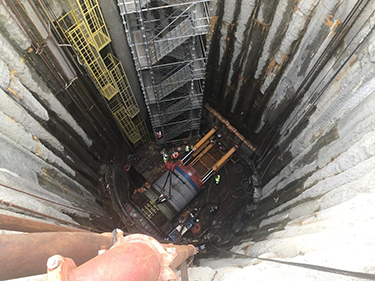|
Subscribe / Renew |
|
|
Contact Us |
|
| ► Subscribe to our Free Weekly Newsletter | |
| home | Welcome, sign in or click here to subscribe. | login |
Construction
| |
November 15, 2022
Work poised to begin on another tunnel in Seattle
Crews are expected to start digging by the end of the month on an 8-foot-diameter tunnel that will run under the Lake Washington Ship Canal to a future 2.7-mile storage tunnel along the canal. The smaller tunnel will run 647 feet between vertical drop shafts in Queen Anne and Fremont.
Inside the 8-foot-diameter casing will be a 42-inch-diameter conveyance pipe that will carry stormwater and sewage to the future storage tunnel during big storms. An 18-inch-diameter conveyance pipe will also be located within the casing. This smaller pipe will also carry stormwater and sewage to the storage tunnel, but during smaller storms. Using the smaller pipe during smaller storms is expected to alleviate low velocity flows — and the risk of sediment deposits — in the 42-inch-diameter pipe.
Seattle Public Utilities says the smaller tunnel will follow a continuous curve below the canal, dodging an existing tunnel holding SPU utility lines and another that moves wastewater for King County. The agency says the slightly more complex curved tunnel saved it from the expense of digging deeper or moving the tunnel's shaft sites off the public right of way, which would have impacted the community much more.
The smaller tunnel is part of the $570 million Ballard-to-Wallingford storage tunnel project that will reduce polluted stormwater and sewage that flow into the Ship Canal, Salmon Bay and Lake Union. SPU and King County Wastewater Treatment Division are leading the project, where the tunneling machine named MudHoney is building the main tunnel.
MudHoney recently passed the halfway point for digging the nearly 19-foot-diameter main tunnel. As of last Thursday, the machine had tunneled 7,137 feet of its 13,946-foot path.
When operational in 2025, the ship canal tunnel will store up to 29.6 million gallons of combined sewer overflows during heavy storms that would otherwise make their way into local waters through seven outfalls. Those CSOs will be stored until they can be processed at the West Point Treatment Plant.
Lane Construction Co. is building the main tunnel and Jacobs is the construction management consultant. The rest of the team includes McMillen Jacobs Associates (no affiliation) of Seattle as design engineer for the storage tunnel and a pump station. Kennedy Jenks is the designer of the smaller conveyance pipeline. Northwest Boring Co. is building the smaller tunnel as a subcontractor to Lane.



